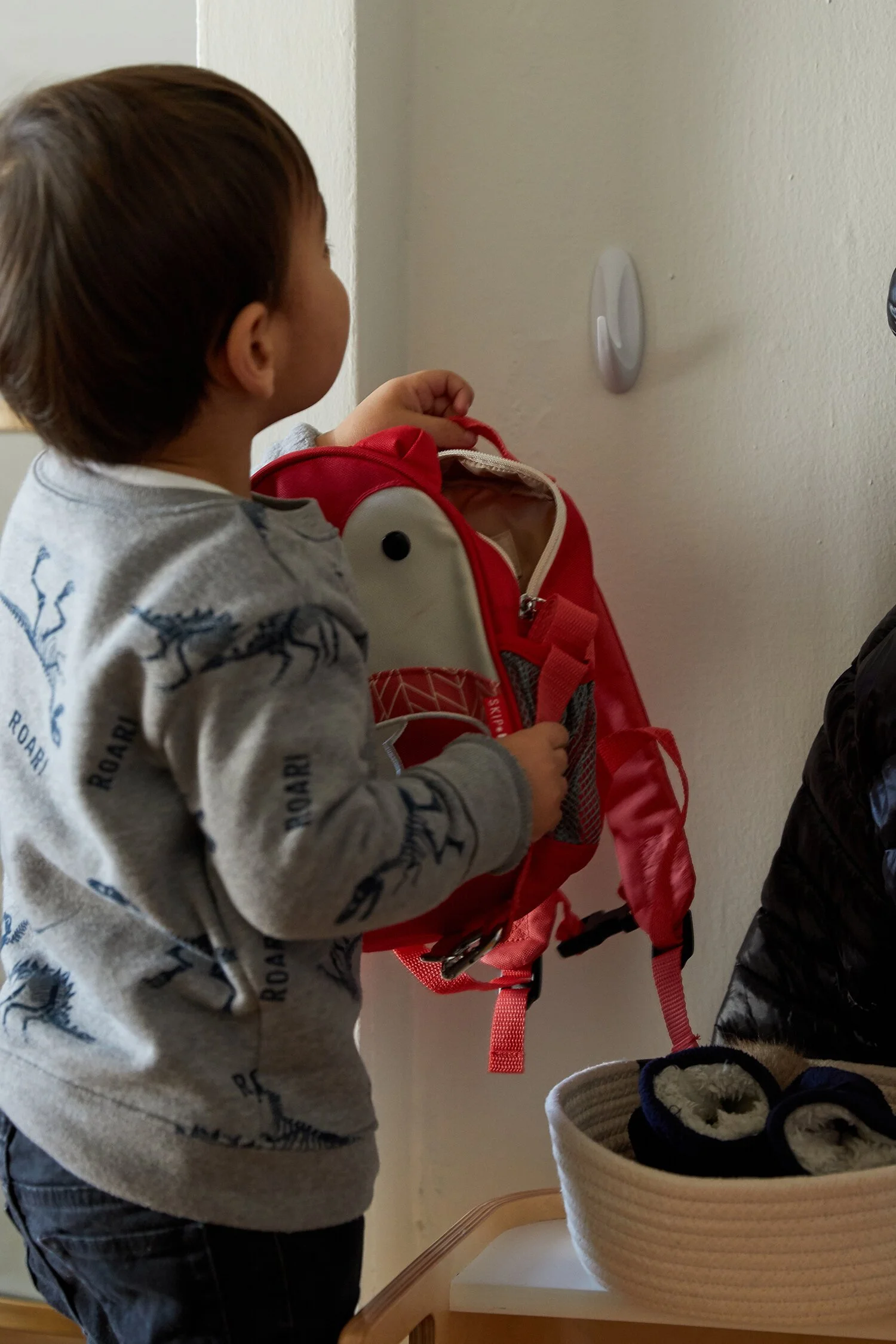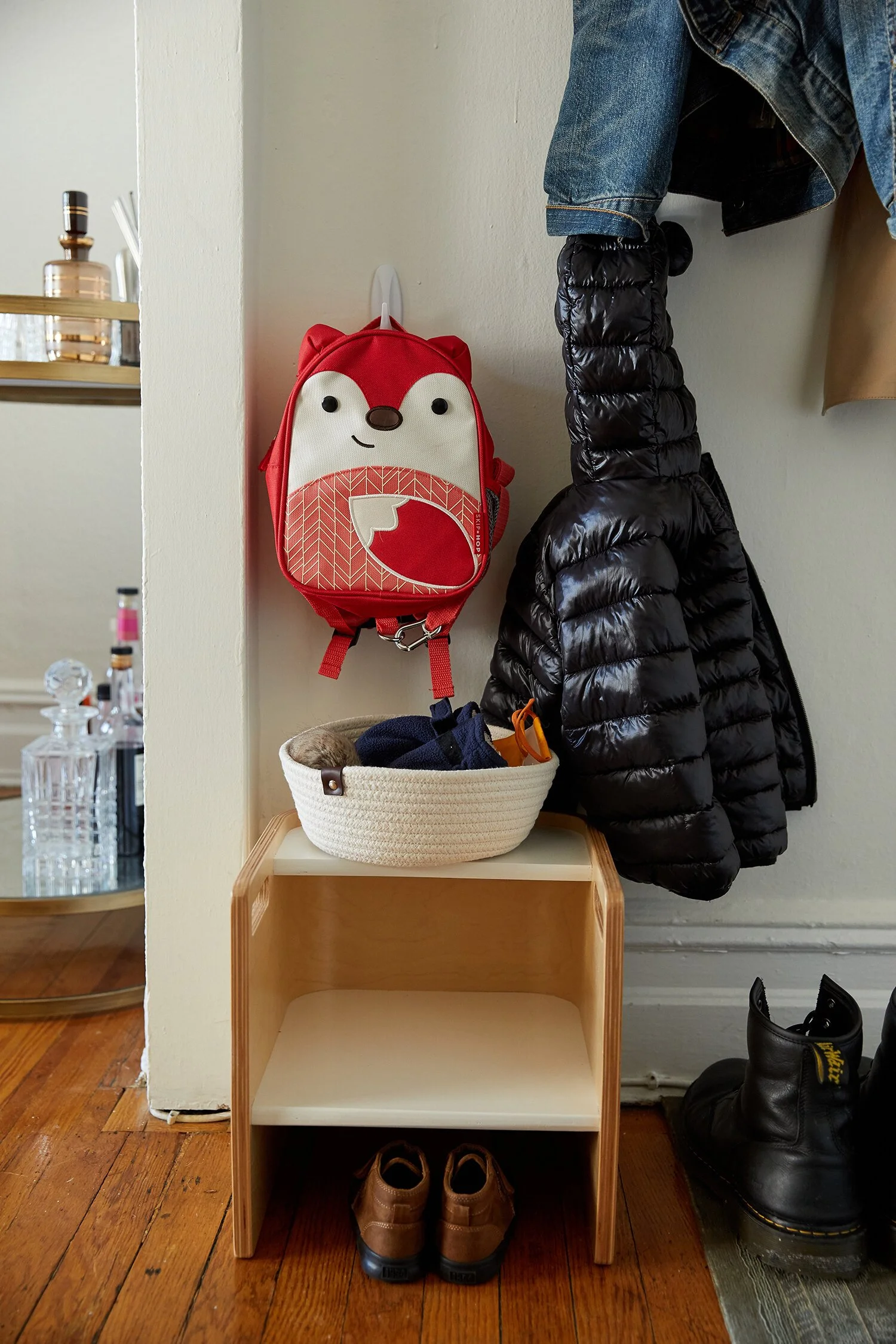10 Ways to Montessori at Home in a Small Apartment
When I look at inspiring images of Montessori bedrooms and furniture, I yearn to have spare rooms to turn into Lee’s bedroom and separate play area. Unfortunately our New York City apartment does not allow me to dedicate all the space I wish I could to a Montessori hand-washing station, a Pikler triangle, or a miniature kitchenette. But there are clever ways to make even tight quarters kid-friendly and a space for your child to practice practical life skills and exercise their independence.
Here are 10 ways to Montessori at home in a small apartment...
1. Set up a baby gate early on.
When Lee was just starting to crawl, I was very opposed to freestanding baby gates; they seemed so sad and better suited for a dog than a child. So I nixed the idea of a baby gate around our living room in favor of constantly chasing after Lee, grabbing him when he got into “no-no zones,” and never allowing him a moment without hearing me shout, “No! Stop! Don’t touch that!” after him.
Suffice to say, I deeply regret not introducing a baby gate early on. It must have been so annoying and frustrating for my curious and developing infant to be abruptly scooped up as he got too close to an off limits area.
Even if it’s simply cordoning off your living room carpet, introducing a freestanding baby gate early on will establish this as safe space where your child is not boxed in, but is offered a place where they can freely explore. Moreover, if you set up the physical gate early on (even before your infant can crawl too quickly), your growing explorer will accept it as a matter of course and a fixture of your house. But, if you wait like I did, your roving little one may protest it and perceive themselves as trapped.
2. Baby-proof your space as much as possible.
Before I was a parent, I always rolled my eyes at overly baby-proofed homes in which every table corner was padded with a tennis ball or foam, even the out of reach cabinets had a child-safety lock on them, and every cup, plate, and utensil is made of plastic. (If I’m being totally honest, there are times when I am still a little, “Is this really necessary?”)
Now that I am a parent of a highly curious toddler, I approach baby-proofing quite differently. Previously I thought baby-proofed homes were to keep your child from ever getting hurt, which yes, of course, it is for that. But it’s also a way for you as a parent to offer your child some independence and freedom-- and relieve yourself of having to incessantly hover over your child to keep them out of trouble.
When it comes to Montessori at home, you want your child to feel like a member of the family and household. A part of that is that they don’t feel highly restricted in the home with too many off-limits areas. So think of baby-proofing not as trying to keep your child from ever getting hurt, but as giving them safe spaces to explore and play, even when you’re not immediately next to them.
3. Store your child’s books on a low shelf and cover-out.
While it’s convenient for an adult to store their books spine-out, it’s much easier for a child to recognize the book they’re looking for if the front cover is facing out. Opt for a Montessori-style bookcase that cascades the books and allows your child to freely access whichever book piques their interest. If your apartment is cozy like ours, we highly recommend this very affordable IKEA Flisat book display that has a small footprint and can easily move around your house as needed.
4. Clear off low shelves to hold your child’s things.
If you have any bookcases or storage units throughout your home, consider if you can clear off the bottom shelf and store a few of your child’s things. For example, we have a bookcase in our living room and the bottom shelf holds three of Lee’s toys with a few books in a low Montessori bookshelf beside it.
(As a friendly reminder, always secure your bookcases and dressers to the wall to ensure your child’s safety, whether they’re allowed access to these spaces or not.)
5. Have step stools handy throughout the house.
Accessibility is key to a Montessori home, but when space is really limited, having a low table or toddler-sized hand washing station may not be an option. Instead have step stools scattered around the house so your child can comfortably wash their hands or participate in preparing their food at the table. You will need to be extra mindful of when your little one uses the stool, but the objective is to bring them up to the “adult level” when you’re not able to bring things down to theirs.
6. Hang hooks, art, and mirrors low.
Maria Montessori pioneered the way for children’s spaces to be scaled down to their size. An extension of that is that Montessori wanted art to be hung at a child’s eye-level so they too could appreciate and admire it, just in the same way adults do.
If you have wall space, affix a bathroom mirror (probably with removable adhesive strips) at your child’s height so they can look at themselves as they comb their hair or wipe their nose. You can similarly hang removable hooks in the closet or near the front door so they can independently hang their jacket or clothes up.
7. Ensure that everything has a designated “home.”
“A place for everything and everything in its place,” is a Montessori mantra. Whether it's your things or your child’s, you want to create a home for your frequently used items-- pens in the kitchen drawer, books on the shelf, phone charger on the desk..
Whether they can reach said space or not, your growing infant will start recognizing that specific items have specific homes and, eventually, they can help with putting dirty laundry in the hamper and returning the washcloth to the bathroom hook. This also sets the precedent that your household is one in which you respect your items, because you take the time to put things away thoughtfully.
8. Carve out a space in your entryway for your toddler to store their belongings.
Place a step stool and a low hook near your front door so your little one can have a place to practice putting on their shoes and coat solo. For more on how to convert your limited entryway space into a Montessori-inspired area, check out our blog post here.
9. Empty out one kitchen cabinet for their plates and bowls.
Kitchen storage space is always tight, but if you can, reserve half of a low kitchen cabinet for your young toddler. Stock this space with their plates, cups, and silverware so they can practice practical life skills like setting the table or helping to put away dishes. This also goes back to having your child as an active member of the household, so they too are expected to pitch in with kitchen chores.
10. Swap their crib for a Montessori or floor bed.
Whether it’s their own room or your bedroom, if the room in which you child sleeps is fully baby-proofed, consider moving your infant into a Montessori floor bed. A Montessori bed is a very low bed (practically on the floor), so your child can freely move on and off the bed. Parents may opt for a floor bed (or even simply a crib mattress on the floor) because it extends the freedom of movement to their child who is now permitted and able to leave their bed instead of waiting for someone to get them from their crib. We have a full blog post dedicated to our experience moving Lee from a crib to a Montessori floor bed which you can read here.
For more pointers on how to Montessori at home, even when space is limited, check out our blog post “How to Create Montessori Spaces in a Small Apartment” which offers more ideas on how you can create Montessori experiences for your children throughout your home.




